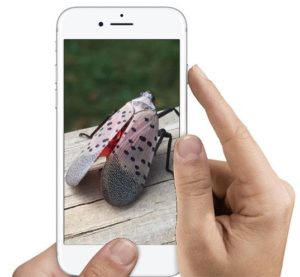It’s official, researchers at Virginia Tech spotted the first Spotted Lanternflies egg hatch for 2020 on April 22nd. This means that homeowners throughout DC, MD, and VA should start to keep an eye out for Spotted Lanternfly nymphs on their trees, shrubs, and vines in the upcoming weeks. Read on to learn what the Spotted Lanternfly is, how it damages plants, and how you as a homeowner can help us track the spread of this invasive insect!
What is the Spotted Lanternfly?

The Spotted Lanternfly is one of the newest invasive insects in our area. Native to China, India, and Vietnam, this insect has been spreading throughout the Eastern United States since it was first discovered in Berks County, Pennsylvania in 2014. This pest poses a great threat to agricultural crops, forests, and high-value ornamentals. Since its discovery, there have been multiple quarantines in place for firewood and products shipped from Pennsylvania. Unfortunately, this has not stopped the spotted lanternfly from spreading to other eastern states. In January 2018, the first lanternflies were found in the greater D.C. region.
Like most plant-sucking insects, the Spotted Lanternfly feeds on the sap from the stems and leaves of trees, shrubs, and vines. This weakens the tree/shrub; attracts other insects, diseases, and fungi; and can eventually contribute to the plant’s death.
Susceptible Species
As nymphs, the Spotted Lanternfly targets grapes, apples, stone fruits, pines, maple, willow, poplar, multiflora rose, sumac, poison ivy, grapevines, and the tree of heaven (Ailanthus). As an adult, the spotted lanternfly mainly feeds on the Ailanthus (Tree of Heaven).
Since this insect loves to feed on fruit trees and grapevines while in their nymph stage, local orchards and wineries could be devastated by this pest. These industries are already taking precautions to protect their plants from these pests, if you have susceptible species on your property or live near an orchard/winery you should too.
Signs & Symptoms
- Weeping wounds/dark streaks down the bark of the tree
- A sap-like substance at the base of the tree
- Black fungus at the base of the tree (sooty mold)
- Increased bee, ant, and wasp activity
- Eggs, Nymphs, or Adult insects on the tree
- Leaves wilting
Treatment for Spotted Lanternflies
Since this pest is new to the United States, researches, government departments, nurseries, and the tree care industry, are all working together to determine the best course of action to treat infected trees and limit the spread of the Spotted Lanternfly. As of today, the best prevention/treatment includes proactive removal of the Ailanthus (Tree of Heaven), egg mass removal, and insecticides. Learn more about treatment.
We Need Your Help!

Join the Spotted Lanternfly “hunt” and help us and the arboriculture community track these insects as they begin to ramp up populations in the DC Metro Area! If you spot an insect or an egg mass that looks like the pictures below, take a quick picture and send it to us at info@rtectreecare.com.
If you submit a picture to us we will confirm the identification of the insect, share it in our newsletter, and send the information to various colleges and institutes around the area that are studying the spread of the Spotted Lanternfly!
How to Identify a Spotted Lanternflies
Spotted lanternflies look very different depending on what stage of their lifecycle they are in. Take a look at the images below to see what Spotted Laternflies look like at every stage.

Now that you know what a Spotted Lanternfly looks like and the negative impact they can have on our local environment/agriculture, keep an eye out and your phones handy to snap a photo of any Spotted Lanternfly you come across.


